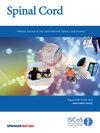Urodynamic evaluation of neurogenic bladder in patients with spinal cord injury within 6 months post-injury: a Retrospective Cross-Sectional Study
IF 2.2
4区 医学
Q3 CLINICAL NEUROLOGY
引用次数: 0
Abstract
Retrospective cross-sectional survey of Korean patients with spinal cord injury (SCI) within 6 months post-injury. To evaluate urodynamic parameters and identify unfavorable urodynamic findings in patients with neurogenic bladder due to SCI during the acute to subacute stages of the disease based on the post-injury time interval. National Rehabilitation Center, Seoul, Korea. Data from urodynamic tests performed on individuals with SCI within 6 months post-injury were collected. Based on the time interval from injury to testing, the recruited patients were divided into three groups: 0–90 days, 91–135 days, and 136–180 days. Based on these groups, urodynamic test parameters and incidence of high-risk findings (high detrusor pressure exceeding 40 cmH2O during the filling phase, low compliance of the bladder, and detrusor-sphincter dyssynergia [DSD]) and unfavorable urodynamic findings (detrusor overactivity [DO], underactive or acontractile bladder) were compared. Analysis of urodynamic study (UDS) findings in 191 individuals with acute to subacute SCI, revealed that unfavorable urodynamic findings were observed within 3 months after injury in both complete and incomplete SCI. The UDS test results and incidence of unfavorable outcomes based on the interval between injury and examination showed no significant statistical differences over time. The urodynamics of individuals with SCI suggest that high-risk or unfavorable urodynamic results are common in the acute to subacute stages of SCI.脊髓损伤后6个月内神经源性膀胱尿动力学评价:一项回顾性横断面研究。
研究设计:对韩国脊髓损伤(SCI)患者伤后6个月内的情况进行回顾性横断面调查:根据受伤后的时间间隔,评估因脊髓损伤导致的神经源性膀胱患者在疾病急性至亚急性阶段的尿动力学参数,并确定不利的尿动力学结果:地点:韩国首尔国立康复中心:方法:收集损伤后 6 个月内对 SCI 患者进行的尿动力学检查数据。根据从受伤到检测的时间间隔,将所招募的患者分为三组:0-90 天组、91-135 天组和 136-180 天组。根据这些组别,比较了尿动力学检查参数和高危结果(充盈期逼尿肌压力超过 40 cmH2O、膀胱顺应性低、逼尿肌-括约肌运动障碍 [DSD])与不利尿动力学结果(逼尿肌过度活动 [DO]、膀胱活动不足或收缩乏力)的发生率:对 191 名急性至亚急性 SCI 患者的尿动力学研究(UDS)结果进行分析后发现,在完全性和不完全性 SCI 患者中,不利的尿动力学结果均出现在损伤后 3 个月内。根据受伤和检查之间的时间间隔,UDS 测试结果和不利结果的发生率在统计上没有明显的时间差异:SCI 患者的尿动力学检查结果表明,在 SCI 的急性和亚急性阶段,高风险或不利的尿动力学结果很常见。
本文章由计算机程序翻译,如有差异,请以英文原文为准。
求助全文
约1分钟内获得全文
求助全文
来源期刊

Spinal cord
医学-临床神经学
CiteScore
4.50
自引率
9.10%
发文量
142
审稿时长
2 months
期刊介绍:
Spinal Cord is a specialised, international journal that has been publishing spinal cord related manuscripts since 1963. It appears monthly, online and in print, and accepts contributions on spinal cord anatomy, physiology, management of injury and disease, and the quality of life and life circumstances of people with a spinal cord injury. Spinal Cord is multi-disciplinary and publishes contributions across the entire spectrum of research ranging from basic science to applied clinical research. It focuses on high quality original research, systematic reviews and narrative reviews.
Spinal Cord''s sister journal Spinal Cord Series and Cases: Clinical Management in Spinal Cord Disorders publishes high quality case reports, small case series, pilot and retrospective studies perspectives, Pulse survey articles, Point-couterpoint articles, correspondences and book reviews. It specialises in material that addresses all aspects of life for persons with spinal cord injuries or disorders. For more information, please see the aims and scope of Spinal Cord Series and Cases.
 求助内容:
求助内容: 应助结果提醒方式:
应助结果提醒方式:


